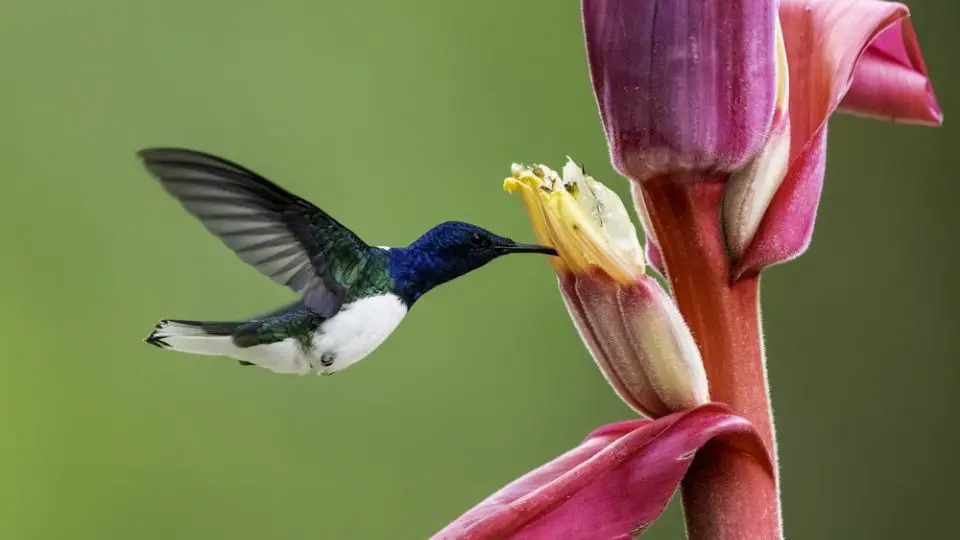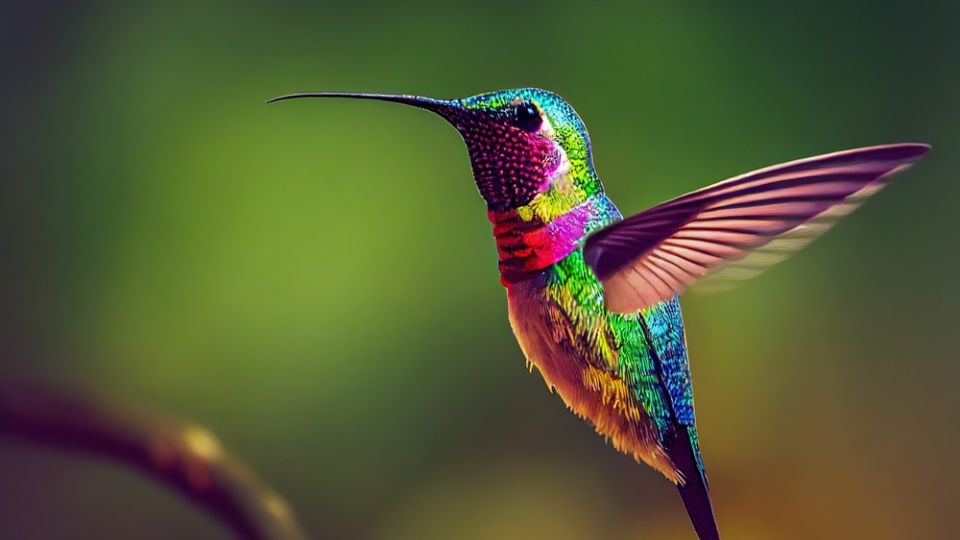Hummingbirds adaptations include a large brain and eyes, heart and lungs that withstand fast flight, an ability to enter torpor, a variable reproductive system, and aggressive behavior that supports their survival instinct.
Hummingbirds (Trochilidae) are magnificent little birds with various adaptations in their anatomy that help them survive. Their respiratory system and wings support the way they fly. On the other hand, their beak and tongue serve them for speedy eating.
Adaptations allow them to maintain a balance of ecological and environmental sustainability. With those traits, they can survive and thrive across Central America, South America, North America, Mexico, and other areas. Check out some hummingbird adaptations that help them survive in complex ecosystems with various other bird species, animals, and insects.
Table of Contents
What Are Some Hummingbird Adaptations?
Hummingbirds have several powerful adaptations that help them survive among way bigger species and many predators. These birds have excellent memory, large eyes, and a highly efficient respiratory system. Check out some of the top adaptations below.
Brain That’s 4.2% Of the Bird’s Weight
If you were wondering how hummingbirds find your yard every year, the answer lies in their brain. It’s 4.2% of their total body weight. This means hummingbirds have the largest brain compared to body size in the bird kingdom.
Their brain helps them remember each flower they visit. They also know when the flower will refill with nectar, so they never miss out on a food source. Plus, this means they recognize you, and might often remind you to refill their feeders.
Large Eyes That Observe Everything
Hummingbird eyes are located on the sides of their heads. They’re very large compared to the overall size of the bird. Additionally, the eye position and size allow hummingbirds to see in front and observe both sides at the same time.
Hummingbirds see colors as people do. Still, they can also see UV light. Their eyes are also protected by at least 12 bones, called ossicles.
Heart and Lungs That Withstand Fast Flight
During the flight, the hummingbird’s heart rate can reach up to 1,250 beats per minute. On the other hand, their resting heart rate drops to about 250 BPM. Their body is capable of circulating blood quickly and delivering oxygen regardless of how fast hummingbirds fly.
Hummingbirds’ lungs also help cool the bird off. Regarding respiration rate, it’s about 250 breaths per minute — about 4 breaths per second. All this helps hummingbirds fly the way they do and quickly rest when needed.
Wings That Beat 200 Times per Second
Hummingbirds fly forward, backward, and change directions, unlike other birds. Their shoulder joint rotates up to 180 degrees and allows for swift movements. These birds can sometimes reach high altitudes and dive up to 60 miles per hour.
To do this, they’ll use the pectoralis major muscle. This muscle is made up of Type I, fast-twitch muscle fibers. It allows for 200 wing beats per second and swift flight.
Body Temperature That Drops During Torpor
While some hummingbirds migrate to warmer areas, some stay around during winter. Those that migrate have adapted to increase their body weight and store fats for longer flights. They’ll eat more as the fall migrating season approaches, and their liver will handle the fat-storing process.
On the other hand, hummingbirds that stay during winter have adapted to manage colder weather. They survive the cold by going into torpor—a state where they reduce their body temperature and hibernate. Their regular body temp is around 105 degrees Fahrenheit. During torpor, it drops to 70. Once the conditions improve, the hummingbird will wake up as if nothing happened.
Reproductive System That Disappears
Even though female hummingbirds are born with two ovaries, one disappears soon after hatching. This makes females lighter for flight. However, the remaining ovary is enough for the female to usually lay 2 eggs after mating. Any unfertilized eggs get reabsorbed in the body.
Male hummingbirds produce sperm in the testes but don’t have a penis. Instead, they’ll mate with the help of the cloaca, like many other birds. Interestingly, hummingbirds’ reproductive organs shrink during non-breeding months to decrease their weight for flight and migration.

What Is the Beak of a Hummingbird Adapted For?
Many believe that a hummingbird’s tongue acts like a straw, but the eating process is slightly more complicated. Hummingbirds have long and narrow beaks, which help them reach the nectar from tubular flowers and feeders. Their lower beak (lower mandible) is also flexible, allowing them to grab the insects mid-air.
Their tongue is also long, and the tip of it is covered in tiny hairs that pull more nectar from the flowers. Plus, their beak is dense and solid, while other bones are hollow. The beak will also control how the tongue moves while eating.
What Are the Adaptations of a Hummingbird’s Legs?
While hummingbirds are excellent flyers, they’re not so great with walking. Their main advantage is the control of their wings, but their legs are their biggest weakness. They can’t walk or jump like other birds since their legs are short and weak, and they have no knees.
Instead, they’ll perch on a branch when they need to rest. Still, they can use their legs to scratch, fight and construct a nest. Their foot is made off of 4 toes, 3 in the front and 1 in the back, which is a typical configuration found in birds that usually perch.
What Is the Most Interesting Adaptation That Hummingbirds Have?
Each species has specific adaptation for their bodies that help them feed, move, or survive. When it comes to hummingbirds, it’s their long beak. It acts as a protective shell for their tongue, which they use to reach the nectar.
Most hummingbirds can also extend and retract their tongues up to 13 times per second. This is why it might look like the bird is licking or sipping up nectar. Plus, these birds can extend their tongues the entire length of their bill.
Hummingbird and Its Aggressive Behavior
Many species of hummingbirds—like the Ruby-throated hummingbird or Rufous hummingbird—are super aggressive in defending their food sources. In a way, this is another one of their adaptations. Being as smart as they are, hummingbirds sense how much they must eat.
Not feeding on sugar water or nectar every 15 minutes is a matter of life or death. This is why they will do anything to defend hummingbird feeders and other food sources. More aggressive kinds are known to chase off other larger birds. Many won’t be afraid of letting you know they need a refill by flying into your face.
Hummingbird’s Survival Instinct
Besides their aggressive behavior, hummingbirds also come with great survival instincts. Adult males will become aggressive and defend their breeding territory as well. This ensures other males go away, and they can mate without interruptions.
Additionally, adult females are responsible for nest building, and they do a fantastic job. Future moms will use lichens and other plant materials to hide their nests in plain sight. Even though they won’t use bird boxes or tree holes, their nests remain hidden in plain sight.

Hummingbird Adaptation Overview
Being excellent pollinators, hummingbirds come with various adaptations. These help them survive, fight off predators, remember food sources, and mate successfully. One of the critical adaptations is related to how their beak and tongue work. Besides the beaks, their muscles and bones help them fly in all directions, and their survival instincts are the reason you keep seeing these birds around each year.

